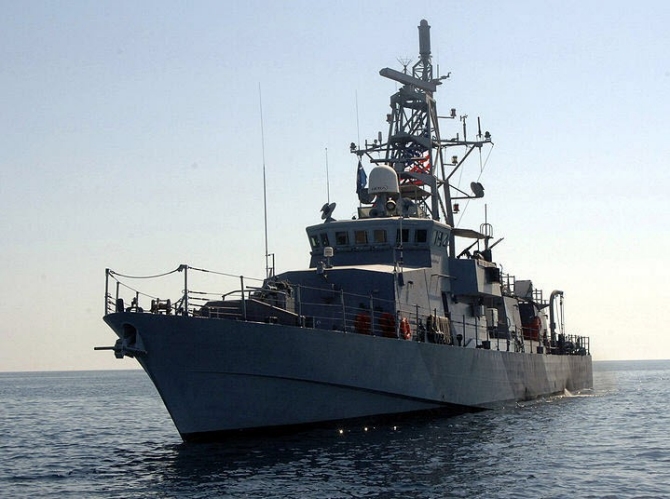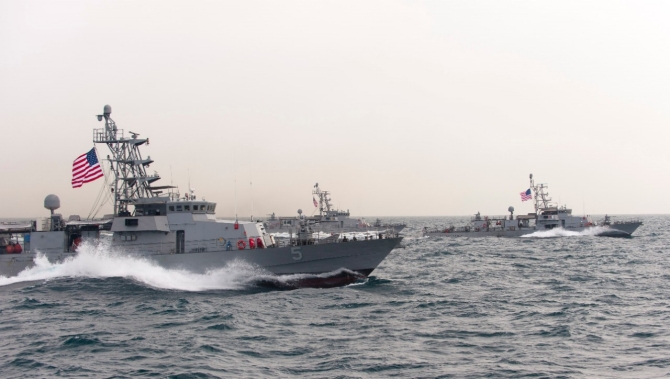Thunderbolt (PC-12)
1995–
A flash of lightning with a simultaneous crash of thunder.
The first U.S. Navy ship named Thunderbolt.
(PC-12: displacement 334; length 178'; beam 25'; draft 8'; speed 32 knots; complement 30; armament 2 25 millimeter, 2 40 millimeter grenade launchers, 2 .50 caliber machine guns, and 2 7.62 millimeter machine guns; class Cyclone)
Thunderbolt (PC-12) was laid down on 16 June 1993 at Lockport, La., by Bollinger Machine Shop and Shipyard; launched on 25 February 1994; sponsored by Mrs. Jane S. Spratt, wife of Representative John M. Spratt Jr., of S.C.; and commissioned on 7 October 1995 at Philadelphia, Pa., Lt. Cmdr. Brad Williamson in command.

Thunderbolt was briefly (5 March–17 July 1998) transferred to the Coast Guard and reclassified to (WPC-12) for an operational test and evaluation program. After completing a Coast Guard homeland security inspection of a liquid gas tanker, the sailors involved brought their rigid hull inflatable boat (RHIB) about, and returned to patrol craft Typhoon (PC-5). While they lay alongside the patrol vessel off Cape Henry, Va., at 0355 on 7 November 2003, swells knocked Typhoon’s 42-year-old Engineman 2nd Class Douglas Bolles into the water. When the coxswain attempted to grab Bolles the RHIB capsized, throwing him into the water. Typhoon’s crew rescued the coxswain, but despite an extensive search by guided missile destroyers Barry (DDG-52), Donald Cook (DDG-75), and Porter (DDG-78), Shamal (PC-13), Sirocco (PC-6), Tempest (PC-2), and Thunderbolt, Coast Guard cutter Albacore (WPB-87309), and aircraft, they failed to find the missing sailor. Fishermen recovered his body about 18 miles east of Back Bay in the Virginia capes during the afternoon watch on 22 November.
In 2013, the Navy forward deployed five of the eight Cyclone-class ships in service -- including Thunderbolt -- to Naval Support Activity Bahrain, as part of a reorganization to better fight the global war on terrorism.


Thunderbolt took part in a coalition training exercise in international waters in the Arabian Gulf on 25 July 2017. The patrol craft steamed in company with guided missile cruiser Vella Gulf (CG-72), two Coast Guard cutters, and an Army logistics vessel. An Iranian Islamic Revolutionary Guard Corps fast attack craft, tentatively identified as Nasr, rapidly closed the coalition ships during the forenoon watch at about 1020. Thunderbolt headed off the intruder from breaking into the allied formation and protected the cruiser and her consorts, but the Iranians dangerously approached to within 150 yards of Thunderbolt, which sounded five short blasts on her whistle, the internationally recognized danger signal. Nasr continued to close, however, so Thunderbolt sounded five more blasts and then fired 11 quick bursts to warn the intruder, and the Iranian boat came about and opened the range.
“The Iranian vessel’s actions,” a Fifth Fleet spokesperson announced, “were not in accordance with the internationally recognized COLREGs [International Regulations for Preventing Collisions at Sea] ‘rules of the road’ nor internationally recognized maritime customs, creating a risk of collision.”
Detailed history pending.
Mark L. Evans
27 July 2017


